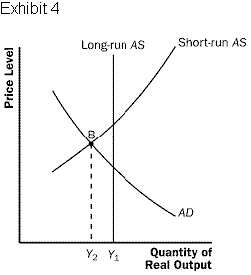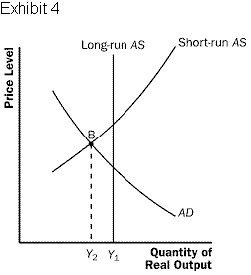True/False
Indicate whether the
sentence or statement is true or false.
|
|
|
1.
|
Over the last 50 years, UK real GDP has grown at
about 5 percent per year.
|
|
|
2.
|
Investment is a particularly volatile component of
spending across the business cycle.
|
|
|
3.
|
An increase in price expectations shifts the
long-run aggregate supply curve to the left.
|
|
|
4.
|
If the classical dichotomy and monetary neutrality
hold in the long run, then the long-run aggregate supply curve should be vertical.
|
|
|
5.
|
Economists refer to fluctuations in output as the
"business cycle" because movements in output are regular and predictable.
|
|
|
6.
|
One reason aggregate demand slopes downward is the
wealth effect: a decrease in the price level increases the value of money holdings and consumer
spending rises.
|
|
|
7.
|
If a country’s central bank increases the
money supply, the aggregate demand curve shifts to the left.
|
|
|
8.
|
The misperceptions theory explains why the long-run
aggregate supply curve is downward sloping.
|
|
|
9.
|
A rise in price expectations that causes wages to
rise causes the short-run aggregate supply curve to shift left.
|
|
|
10.
|
If the economy is in a recession, the economy will
adjust to long-run equilibrium on its own as wages and price expectations rise.
|
|
|
11.
|
In the short run, if the government cuts back
spending to balance its budget, it will probably cause a recession.
|
|
|
12.
|
The short-run effect of an increase in aggregate
demand is an increase in output and an increase in the price level.
|
|
|
13.
|
A rise in the price of oil tends to cause
stagflation.
|
|
|
14.
|
In the long run, an increase in government spending
tends to increase output and prices.
|
|
|
15.
|
If policy makers choose to try to move the economy
out of a recession, they should use their policy tools to decrease aggregate demand.
|
Multiple Choice
Identify the
letter of the choice that best completes the statement or answers the question.
|
|
|
16.
|
Which of the following statements about economic
fluctuations is true?
a. | None of these answers | b. | A depression is a mild recession. | c. | A variety of spending, income, and output measures can be used to measure
economic fluctuations because most macroeconomic quantities tend to fluctuate
together. | d. | A recession is when output rises above the natural rate
of output. | e. | Economic
fluctuations have been termed the "business cycle" because the movements in output are
regular and predictable. |
|
|
|
17.
|
According to the interest rate effect, aggregate
demand slopes downward (negatively) because
a. | lower prices increase money holdings, decrease lending,
interest rates rise, and investment spending falls. | b. | lower prices increase the value of money holdings and consumer spending
increases. | c. | lower prices
decrease the value of money holdings and consumer spending decreases. | d. | lower prices reduce money holdings, increase lending, interest rates fall, and
investment spending increases. |
|
|
|
18.
|
Which of the following would not cause a shift in
the long-run aggregate supply curve?
a. | All of these answers shift the long-run aggregate supply
curve. | b. | An increase in the available
capital | c. | An increase in the available
labour | d. | An increase in the available
technology | e. | An increase in
price expectations |
|
|
|
19.
|
Which of the following is not a reason why the
aggregate demand curve slopes downward?
a. | The exchange-rate effect | b. | The wealth effect. | c. | The classical
dichotomy/monetary neutrality effects. | d. | The interest-rate
effect | e. | All of these answers are reasons why the
aggregate-demand curve slopes downward. |
|
|
|
20.
|
In the model of aggregate demand and aggregate
supply, the initial impact of an increase in consumer optimism is to
a. | shift the short-run aggregate supply curve to the
left. | b. | shift the aggregate demand curve to the
right. | c. | shift the short-run aggregate supply curve to the
right. | d. | shift the aggregate demand curve to the
left. | e. | shift the long-run aggregate supply curve to the
left. |
|
|
|
21.
|
Which of the following statements is true regarding
the long-run aggregate supply curve? The long-run aggregate supply curve
a. | is vertical because an equal change in all prices and
wages leaves output unaffected. | b. | is positively
sloped because price expectations and wages tend to be fixed in the long
run. | c. | shifts right when the government raises the minimum
wage. | d. | shifts left when the natural rate of unemployment
falls. |
|
|
|
22.
|
According to the wealth effect, aggregate demand
slopes downward (negatively) because
a. | lower prices increase the value of money holdings and
consumer spending increases. | b. | lower prices
decrease the value of money holdings and consumer spending decreases. | c. | lower prices reduce money holdings, increase lending, interest rates fall, and
investment spending increases. | d. | lower prices
increase money holdings, decrease lending, interest rates rise, and investment spending
falls. |
|
|
|
23.
|
The natural rate of output is the amount of real
GDP produced
a. | when the economy is at the natural rate of
unemployment. | b. | when the economy
is at the natural rate of investment. | c. | when the economy
is at the natural rate of aggregate demand. | d. | when there is no
unemployment. |
|
|
|
24.
|
Suppose the price level falls but because of fixed
nominal wage contracts, the real wage rises and firms cut back on production. This is a demonstration
of the
a. | sticky-wage theory of the short-run aggregate supply
curve. | b. | classical dichotomy theory of the short-run aggregate
supply curve. | c. | misperceptions
theory of the short-run aggregate supply curve. | d. | sticky-price
theory of the short-run aggregate supply curve. |
|
|
|
25.
|
Suppose the price level falls but suppliers only
notice that the price of their particular product has fallen. Thinking there has been a fall in the
relative price of their product, they cut back on production. This is a demonstration of
the
a. | misperceptions theory of the short-run aggregate supply
curve. | b. | classical dichotomy theory of the short-run aggregate
supply curve. | c. | sticky-price
theory of the short-run aggregate supply curve. | d. | sticky-wage theory
of the short-run aggregate supply curve. |
|
|
|
26.
|
Suppose the economy is initially in long-run
equilibrium. Then suppose there is a increase in military spending due to rising international
tensions. According to the model of aggregate demand and aggregate supply, what happens to prices and
output in the short run?
a. | Prices fall; output rises. | b. | Prices fall; output falls. | c. | Prices rise; output falls. | d. | Prices rise; output rises. |
|
|
|
27.
|
Suppose the economy is initially in long-run
equilibrium. Then suppose there is a increase in military spending due to rising international
tensions. According to the model of aggregate demand and aggregate supply, what happens to prices and
output in the long run?
a. | Output falls; prices are unchanged from the initial
value. | b. | Prices fall; output is unchanged from its initial
value. | c. | Output and the price level are unchanged from their
initial values. | d. | Prices rise;
output is unchanged from its initial value. | e. | Output rises;
prices are unchanged from the initial value. |
|
|
|
28.
|
Suppose the economy is initially in long-run
equilibrium. Then suppose there is a drought that destroys much of the wheat crop. According to the
model of aggregate demand and aggregate supply, what happens to prices and output in the short
run?
a. | Prices rise; output falls. | b. | Prices fall; output rises. | c. | Prices rise; output rises. | d. | Prices fall; output falls. |
|
|
|
29.
|
Suppose the economy is initially in long-run
equilibrium. Then suppose there is a drought that destroys much of the wheat crop. If policymakers
allow the economy to adjust to long-run equilibrium on its own, according to the model of aggregate
demand and aggregate supply, what happens to prices and output in the long run?
a. | Output rises; prices are unchanged from the initial
value. | b. | Output and the price level are unchanged from their
initial values. | c. | Output falls;
prices are unchanged from the initial value. | d. | Prices fall;
output is unchanged from its initial value. | e. | Prices rise;
output is unchanged from its initial value. |
|
|
|
30.
|
Stagflation occurs when the economy
experiences
a. | rising prices and rising
output. | b. | rising prices and falling
output. | c. | falling prices and falling
output. | d. | falling prices and rising
output. |
|
|
|
31.
|
Which of the following events shifts the short-run
aggregate supply curve to the right?
a. | a decrease in the money
supply | b. | a drop in oil prices | c. | an increase in government spending on military
equipment | d. | none of these answers | e. | an increase in price expectations |
|
|
|
32.
|

Refer to Exhibit 4. Suppose the
economy is operating in a recession such as point B in Exhibit 4. If policymakers wished to move
output to its long-run natural rate, they should attempt to
a. | shift aggregate demand to the
left. | b. | shift short-run aggregate supply to the
left. | c. | shift aggregate demand to the
right. | d. | shift short-run aggregate supply to the
right. |
|
|
|
33.
|

Refer to Exhibit 4. Suppose the economy is operating in a recession such
as point B in Exhibit 4. If policymakers allow the economy to adjust to the long-run natural rate on
its own,a. | people will reduce their price expectations and the
short-run aggregate supply will shift right. | b. | people will raise
their price expectations and aggregate demand will shift left. | c. | people will raise their price expectations and the short-run aggregate supply
will shift left. | d. | people will reduce
their price expectations and aggregate demand will shift
right. |
|
|
|
34.
|
According to the model of aggregate supply and
aggregate demand, in the long run, an increase in the money supply should cause
a. | prices to rise and output to
rise. | b. | prices to fall and output to remain
unchanged. | c. | prices to fall and
output to fall. | d. | prices to rise and
output to remain unchanged. |
|
|
|
35.
|
Policy makers are said to "accommodate"
an adverse supply shock if they
a. | fail to respond to the adverse supply shock and allow
the economy to adjust on its own. | b. | respond to the
adverse supply shock by decreasing aggregate demand, which lowers prices. | c. | respond to the adverse supply shock by decreasing short-run aggregate
supply. | d. | respond to the adverse supply shock by increasing
aggregate demand, which further raises prices. |
|